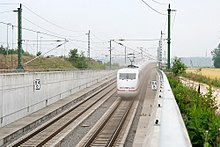Rapid braking

In the railway sector, rapid braking is braking with maximum braking force and the fastest possible effect and is one of five or six types of braking. As a rule, it is only used by the driver in an emergency. The rapid braking is to be distinguished from the service braking, under which all braking levels are summarized, which are used in normal operation; However, it is possible that the effectiveness of the highest service braking level ( full braking ) coincides with the effectiveness of the emergency braking. If an emergency brake is triggered by the vehicle or the train protection , one speaks of an emergency brake .
From a technical point of view, rapid braking with an indirectly acting compressed air brake is triggered by completely venting the main air line ("HL", formerly "HLL") in the shortest possible time . This is done via the driver's brake valve . As a result, the pressure in the HL drops from 5 bar in a very short time to ambient pressure, whereby all the brakes that are switched on regulate the maximum brake cylinder pressure. In addition, any magnetic rail brakes that may be present become effective at speeds above 50 km / h . The drop in HL pressure is also detected on working locomotives, which leads to the drive power being switched off and the dynamic brake (if present) being activated. In addition, some passenger coaches use rapid braking accelerators, which accelerate the pressure drop, but not the propagation of the signal.
Rapid braking usually works until the vehicle comes to a standstill, often even if the trigger has been removed in the meantime, as the braking can only be released slowly. Rapid braking can therefore usually be recognized by a strong holding jerk.
While in the past all safety devices (such as Sifa , PZB , LZB , monitoring of the spring-loaded brakes) issued an automatic brake when responding , today there is a shift towards only outputting reduced braking under certain circumstances. The actuation of a passenger emergency brake handle on the ICE of Deutsche Bahn also leads to an emergency stop (see also emergency brake override ).
See also
Individual evidence
- ↑ Guideline 408 - Driver Service Regulations (Module 408.2581, page 1 and 408.2671, page 1): [1]
- ^ Jürgen Janicki, Horst Reinhard, Michael Rüffer: Rail vehicle technology DB specialist book . Ed .: Bahn Fachverlag GmbH in cooperation with DB Training, Learning & Consulting. 3. Edition. ISBN 978-3-943214-07-9 , pp. 319 .